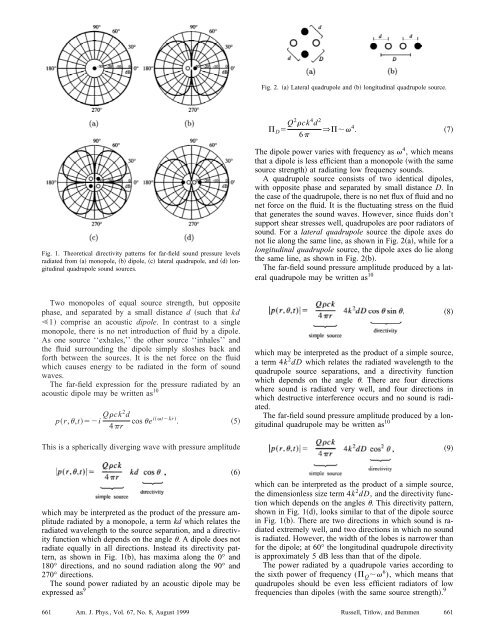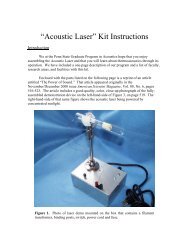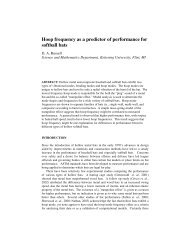Acoustic monopoles, dipoles, and quadrupoles
Acoustic monopoles, dipoles, and quadrupoles
Acoustic monopoles, dipoles, and quadrupoles
Create successful ePaper yourself
Turn your PDF publications into a flip-book with our unique Google optimized e-Paper software.
Fig. 1. Theoretical directivity patterns for far-field sound pressure levels<br />
radiated from �a� monopole, �b� dipole, �c� lateral quadrupole, <strong>and</strong> �d� longitudinal<br />
quadrupole sound sources.<br />
Two <strong>monopoles</strong> of equal source strength, but opposite<br />
phase, <strong>and</strong> separated by a small distance d �such that kd<br />
�1� comprise an acoustic dipole. In contrast to a single<br />
monopole, there is no net introduction of fluid by a dipole.<br />
As one source ‘‘exhales,’’ the other source ‘‘inhales’’ <strong>and</strong><br />
the fluid surrounding the dipole simply sloshes back <strong>and</strong><br />
forth between the sources. It is the net force on the fluid<br />
which causes energy to be radiated in the form of sound<br />
waves.<br />
The far-field expression for the pressure radiated by an<br />
acoustic dipole may be written as 10<br />
p�r,�,t���i Q�ck2 d<br />
4�r<br />
cos �e i��t�kr� . �5�<br />
This is a spherically diverging wave with pressure amplitude<br />
which may be interpreted as the product of the pressure amplitude<br />
radiated by a monopole, a term kd which relates the<br />
radiated wavelength to the source separation, <strong>and</strong> a directivity<br />
function which depends on the angle �. A dipole does not<br />
radiate equally in all directions. Instead its directivity pattern,<br />
as shown in Fig. 1�b�, has maxima along the 0° <strong>and</strong><br />
180° directions, <strong>and</strong> no sound radiation along the 90° <strong>and</strong><br />
270° directions.<br />
The sound power radiated by an acoustic dipole may be<br />
expressed as 9<br />
�6�<br />
Fig. 2. �a� Lateral quadrupole <strong>and</strong> �b� longitudinal quadrupole source.<br />
� D� Q2 �ck 4 d 2<br />
6� ⇒���4 . �7�<br />
The dipole power varies with frequency as � 4 , which means<br />
that a dipole is less efficient than a monopole �with the same<br />
source strength� at radiating low frequency sounds.<br />
A quadrupole source consists of two identical <strong>dipoles</strong>,<br />
with opposite phase <strong>and</strong> separated by small distance D. In<br />
the case of the quadrupole, there is no net flux of fluid <strong>and</strong> no<br />
net force on the fluid. It is the fluctuating stress on the fluid<br />
that generates the sound waves. However, since fluids don’t<br />
support shear stresses well, <strong>quadrupoles</strong> are poor radiators of<br />
sound. For a lateral quadrupole source the dipole axes do<br />
not lie along the same line, as shown in Fig. 2�a�, while for a<br />
longitudinal quadrupole source, the dipole axes do lie along<br />
the same line, as shown in Fig. 2�b�.<br />
The far-field sound pressure amplitude produced by a lateral<br />
quadrupole may be written as 10<br />
which may be interpreted as the product of a simple source,<br />
a term 4k 2 dD which relates the radiated wavelength to the<br />
quadrupole source separations, <strong>and</strong> a directivity function<br />
which depends on the angle �. There are four directions<br />
where sound is radiated very well, <strong>and</strong> four directions in<br />
which destructive interference occurs <strong>and</strong> no sound is radiated.<br />
The far-field sound pressure amplitude produced by a longitudinal<br />
quadrupole may be written as 10<br />
which can be interpreted as the product of a simple source,<br />
the dimensionless size term 4k 2 dD, <strong>and</strong> the directivity function<br />
which depends on the angles �. This directivity pattern,<br />
shown in Fig. 1�d�, looks similar to that of the dipole source<br />
in Fig. 1�b�. There are two directions in which sound is radiated<br />
extremely well, <strong>and</strong> two directions in which no sound<br />
is radiated. However, the width of the lobes is narrower than<br />
for the dipole; at 60° the longitudinal quadrupole directivity<br />
is approximately 5 dB less than that of the dipole.<br />
The power radiated by a quadrupole varies according to<br />
the sixth power of frequency (� Q�� 6 ), which means that<br />
<strong>quadrupoles</strong> should be even less efficient radiators of low<br />
frequencies than <strong>dipoles</strong> �with the same source strength�. 9<br />
661 Am. J. Phys., Vol. 67, No. 8, August 1999 Russell, Titlow, <strong>and</strong> Bemmen<br />
661<br />
�8�<br />
�9�








